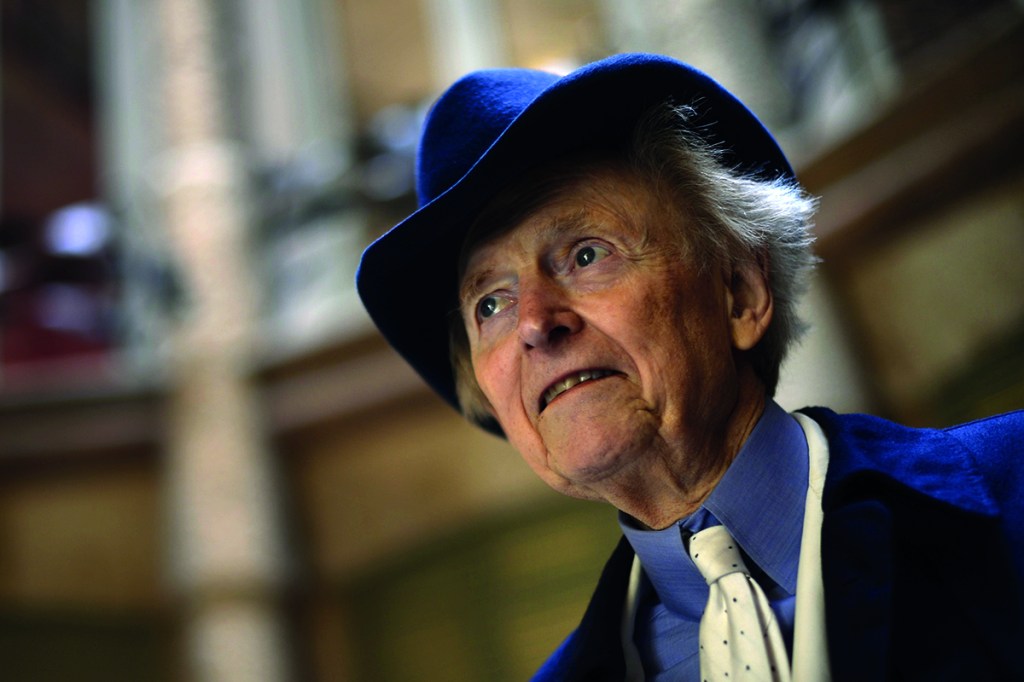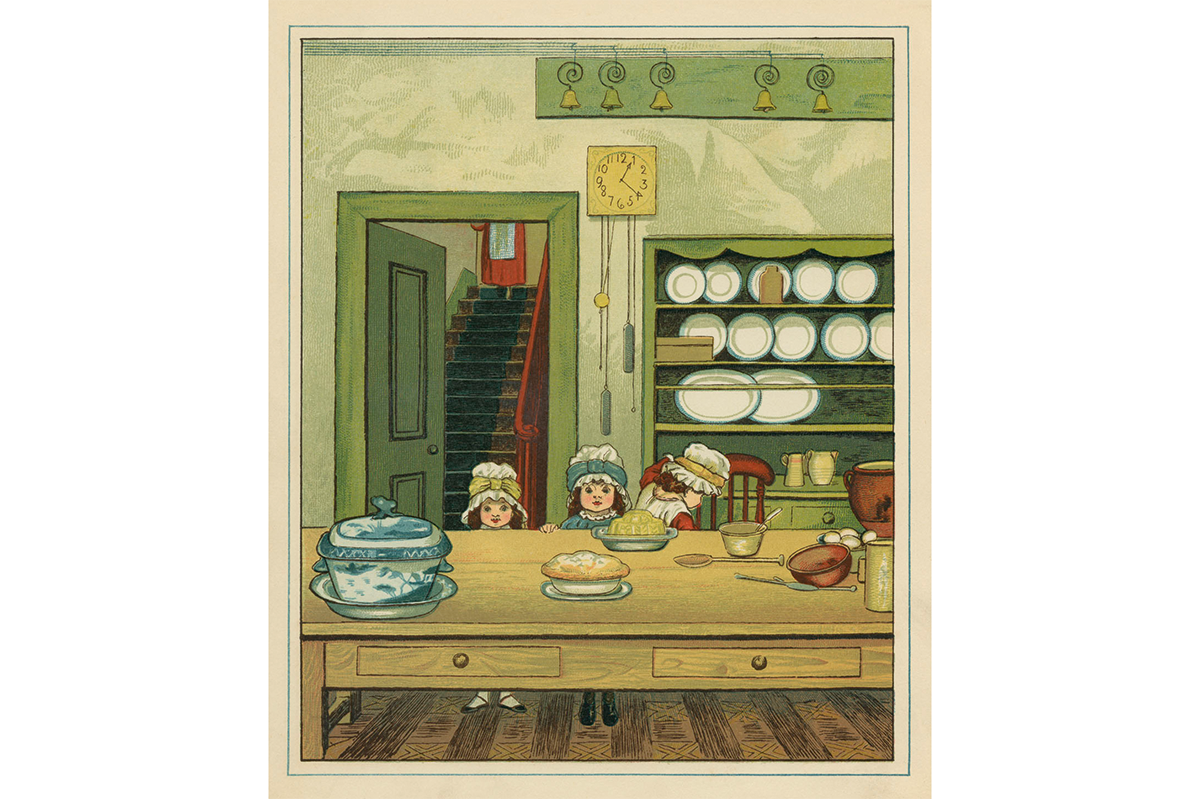I was introduced to Tom Wolfe in the late 1970s, a year or two after I had begun my journalistic career as the literary editor at National Review, by Timothy Dickinson — an Oxford man working for Lewis Lapham, then editor of Harper’s — who was (as he doubtless remains) the sole ambulatory compendium of the British Museum. As Wolfe was fond of Middle Eastern cuisine, we met for lunch at a Lebanese place in Manhattan’s Garment District.
While saying goodbye on the sidewalk out front of the restaurant after the meal, Timothy dropped his walking stick which was headless; only the screw that had once fastened the missing head in place protruding from the top of the shaft. Timothy dropped to the pavement, where he remained, a portly figure in a morning coat and striped trousers, as he groped blindly on all fours about the feet of the columnar figure of Wolfe, dressed in shining white linen, for his stick and monocle: impassive.
The New Journalism, of which Tom Wolfe was the principal inventor along with Dr Hunter S. Thompson and a few others in the early 1960s, is now as dead as the penny dreadfuls and the jingo journalism of the early 1900s. Wolfe was convinced that the death of the novel, whose imagined demise was being widely discussed in the literary journals of the period, was an actual fact. If that were indeed the case, he reasoned, some new literary form was needed to replace it.
His answer to this need was participatory journalism, in which journalists realized their reportorial subjects as novelistic characters and the reporter inserted himself among them and joined in their activities on the printed page. Active participation was Rule Number One; Rule Number Two was immediacy. The trick was to catch and convey the freneticism, the exaggeration, the hyper-pace, the hyper-stimulation and the hyper-sexuality that distinguished what Wolfe named the Purple Decades — fueled by revolutionary enthusiasms, booze and, above all, drugs — through the relentless deployment of a style similar to that of the morning radio shows, its breathless quality suggested by the liberal use of ellipses.
The technique was effective, compelling and exciting, but it was not entirely original, Wolfe having borrowed it directly from Céline, the French novelist of the pre-war period whom he admired. And it had three significant weaknesses: the extent to which it courted self-parody; its easy imitability; and the degree to which stylistic excitement gave way to monotony of tone (always the same key and mood) and of voice, as the authorial one, merging with those of the subject-characters, produced a hyped stream of consciousness accentuated by a relentless beat as tiresome, finally, as rap music’s.Wolfe was a highly skilled writer, yet he — like Céline — was a textbook example of how a writer writes when, having no true style of his own, he tries to conceal the fact. A careful reader will note how, in the fiction as in the journalistic essays, on the occasions when Wolfe lapses for practical reasons into straightforward prose (Radical Chic offers many examples of this), the writing is indistinguishable from that found in the commercial magazines.
In 1987, more than two decades after Wolfe had announced that the novel was kaput, he published his first book-length venture into fiction, The Bonfire of the Vanities, about a wealthy Manhattan bond salesman and socialite pursued and brought down on a charge of vehicular manslaughter after hitting a black man in the Bronx while he has his mistress in the car with him. With A Man in Full (1998), his next novel, published nearly a dozen years later, Wolfe shifted his attention from NewYork to Atlanta and the New South personified by Charlie Croker, a nouveau riche conglomerate magnate going broke in the context of a dysfunctional society riven by historic racial tensions further aggravated by the presence of illegal immigrants from Asia. The book provoked devastating criticism from John Updike, John Irving and Norman Mailer, who appeared to have been lying in wait for an opportunity to deny that Tom Wolfe was a novelist at all and witheringly panned his prose style, along with everything else. As Bonfire and A Man qualify by all reasonable standards as novels, the issue was rather whether they are good novels — more precisely, whether they are literary novels as publishers and critics understand the term, or merely specimens of what Dwight MacDonald called ‘midcult’.
Joseph Conrad said that his aim in writing fiction was to ‘render the highest possible justice to the visible universe’. Flannery O’Connor argued that the subject of a novel ‘should be one of the highest importance’. By these standards Tom Wolfe, who had no interest in what the great novelists are concerned with or in discovering what the novel as an art form is capable of, was plainly not a ‘serious’ novelist.
Wolfe seems never to have made up his mind when at work on a novel whether he was writing journalism or fiction. All of his novels are overlong, owing to the frequent interruption of the narrative line by reportorial longueurs filled with tediously detailed sociological descriptions drawn from the notebooks of a working journalist. Wolfe stubbornly resisted the primary rule of the modern(ist)novelist: ‘Show, don’t tell.’A century and a half earlier, Balzac, Wolfe’s literary apotheosis, had succeeded in doing both: Balzac was expert in creating characters who were not only realistic and true, but interesting as well. The dramatis personae of Bonfire, Wolfe’s best and indeed only successful novel, are real enough, yet they are nothing more than banal and wholly uninteresting sociological specimens.
In fiction as in journalism, Wolfe excelled at capturing human foibles and petty vanities; anything deeper than that escaped him. By the end of Bonfire, Sherman McCoy’s vanity is shaken, but otherwise he remains unaltered and unenlightened by his humiliating ordeal. Interiority with Wolfe is limited to reactive mental and emotional gestures put into italics to indicate that they are unspoken thoughts. As a social document, The Bonfire of the Vanities is devastating, brilliant and often comical; as literature it is nothing more than an entertaining example of popular fiction, whose point is comprehensively expressed by Police Detective Martin when he remarks to his partner, ‘Bullshit reigns’ — a concise and accurate summation of contemporary America according to Wolfe.
Unlike Bonfire, A Man in Full evinces no attempt at a literary style. Nor does it suggest a familiarity on the author’s part with literature beyond the magazines and popular fiction. As a journalist Wolfe was keen to explore the 20th- and 21st-century American workplace as Sinclair Lewis had done in the Twenties, Thirties and Forties with Babbitt (real estate), Elmer Gantry (evangelical Christianity), Arrowsmith (medicine), Ann Vickers (the career woman) and Dodsworth (the automotive industry). Unlike Lewis, who ignored the technicalities of these occupations, Wolfe devoted inordinate attention and space to detailed descriptions of bond sellers at their computer terminals on Wall Street (Bonfire), New South corporatists getting rich and losing everything in Atlanta (A Man in Full) and policing in Miami (Back to Blood).
The three novels show the late-arriving novelist relapsing toward journalism — journalism deprived, however, of the wit, brilliance, deadly satire, freshness, inventiveness, ebullience and high humor of The Electric Kool-Aid Acid Test (1968) and previous works. Worse, when Wolfe tries to resurrect these qualities by resorting to the old tricks, they don’t work for him anymore. A Man in Full needs a cylinder of laughing gas at hand to get through, while Blood is an appalling and truly embarrassing performance: a book that a high school student in a gifted-and-talented class might have produced. Sinclair Lewis at his worst never wrote so banally and so badly.
In his late sixties Wolfe was stricken by a heart attack. Following his illness he succumbed, by his own account, to ‘a towering depression’ brought on by doubts about the literary importance and lasting value of his work. Apparently he became, as he aged, more ambitious as a writer. (He was devastated by Updike’s and Irving’s assault). Certainly he lacked the makings of a great novelist, or even a first-rate one; his instincts and abilities were those of a journalist — and what shame is there in that? G.K. Chesterton, a journalist and author of genius, wrote clever and amusing novels that were really dramatized essays.
In his admiration for Balzac, Wolfe ignored the late-19th-century modernist tradition that, reimagining prose fiction as poetic in quality, influenced American writers as recent as Flannery O’Connor and Cormac McCarthy; his aim was to resurrect the double-decker social novel of the 19th century. By 1987, when Bonfire was published, the modernist tradition of Firbank, Hemingway, Waugh, Faulkner and co. was finished, but ‘serious’ novelists like Updike continued to take modernism as their literary gold standard. It was thus inevitable that he should have found The Bonfire of the Vanities carelessly written, inelegant, shallow and formless, as well as hopelessly journalistic in Wolfe’s determination to be ‘contemporary’ by packing the text with evanescent cultural markers, including brand names, that were guaranteed to suggest nothing to anyone a few decades hence.
Though Wolfe was never the great writer he finally aspired to be, he was a first-rate social observer and chronicler — a ‘social X-ray’ in his own right — and a superb satirist whose nonfiction and essayistic works are almost unfailingly clever, witty, imaginative and skillfully written. Most important of all, he had an unerring instinct for what we might call le cible just, the perfect target: the rich limousine liberal, the fatuous, shallow, hypocritical and parasitic pseudo-intellectual and artist, and — finally — the liberal mystique itself.
It is a mystery how the butts of his satire could have lionized Wolfe at the time, as indeed they still do. Could the answer be a certain thickheadedness? The inability to read a text critically and grasp its meaning and intent? I suggest the explanation is rather the inability of modern liberals to see themselves as others see them, even when the likeness is painted in bold strokes and loud colors and suspended against a starkly white wall before their unseeing eyes.
This article was originally published in The Spectator’s November 2020 US edition.

























